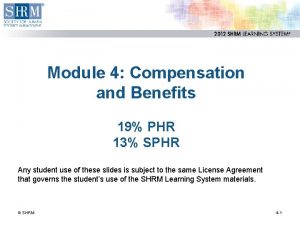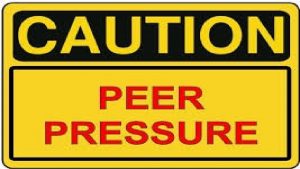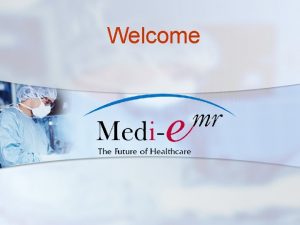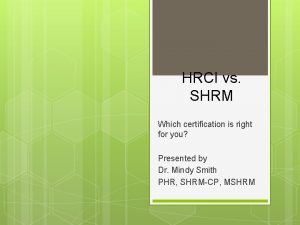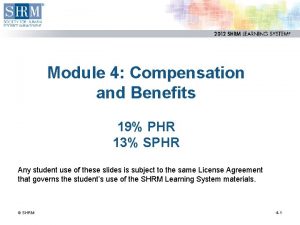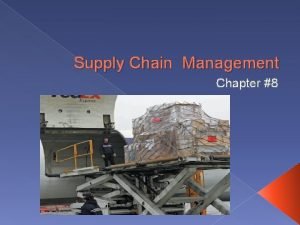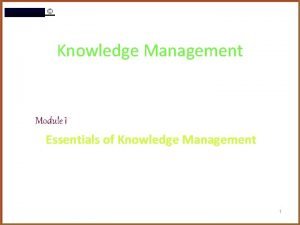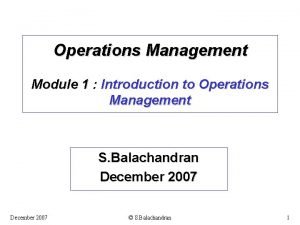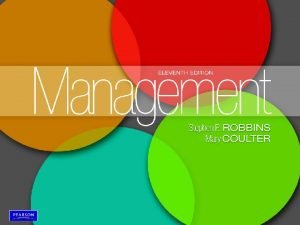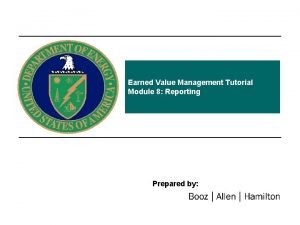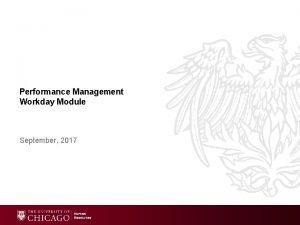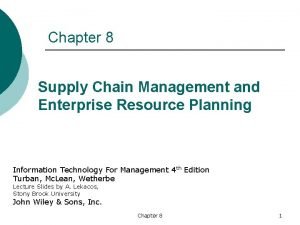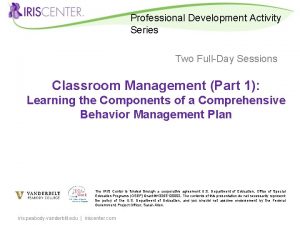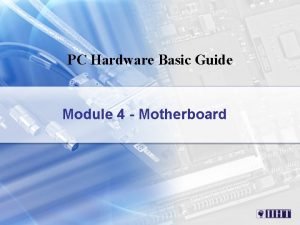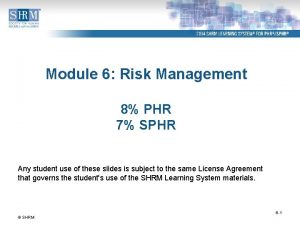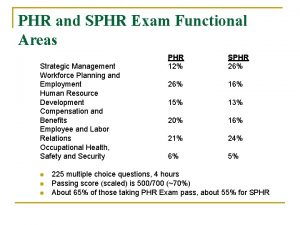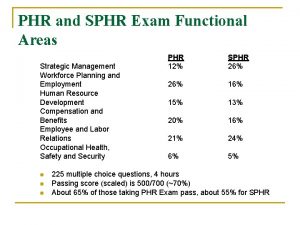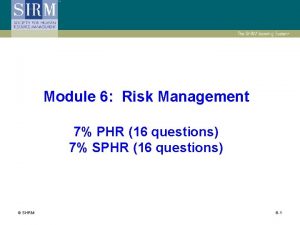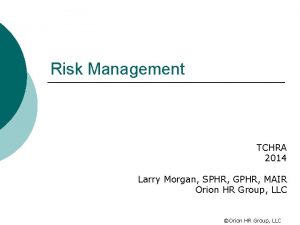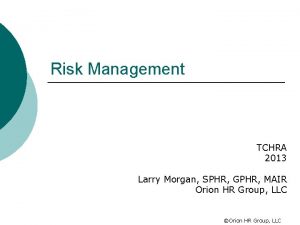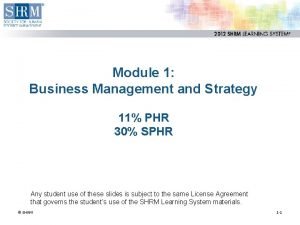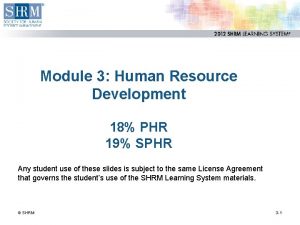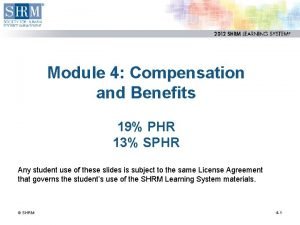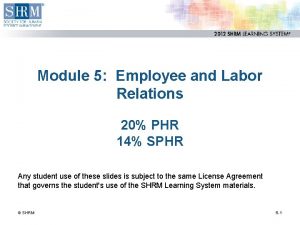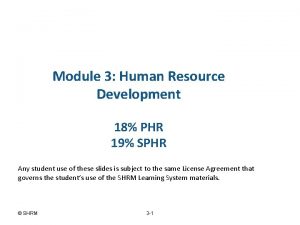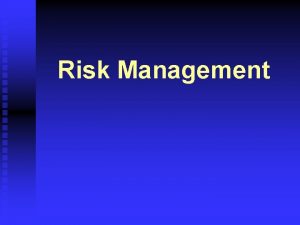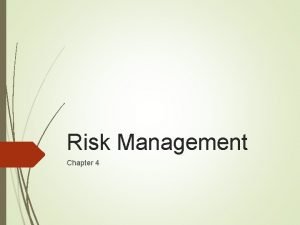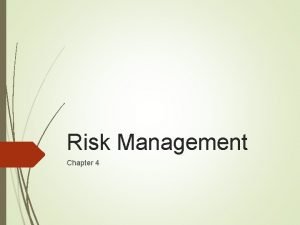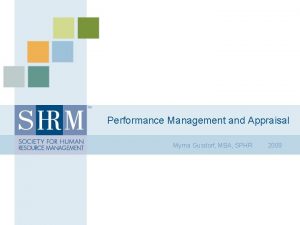Module 6 Risk Management 8 PHR 7 SPHR







































- Slides: 39

Module 6: Risk Management 8% PHR 7% SPHR Any student use of these slides is subject to the same License Agreement that governs the student's use of the SHRM Learning System materials. © SHRM 6 -1

Categories of Operational Risk • • • Personnel risk (fraud and error) Physical assets (business environments) Technology (viruses) Relationships (lawsuits) External/regulatory (external fraud) HR role: Examine HR policies to prevent or mitigate loss and ensure business continuity. © SHRM 6 -2

Risk Management Techniques Tools: Risk management software systems and risk management scorecard © SHRM 6 -3

Continuity and Recovery Business continuity planning • Identifies potential threats and impacts. • Plans for disruption, interruption, or loss of business functions. Disaster recovery planning • A set of guidelines and procedures to be used by an organization for the recovery of business operations due to disasters such as earthquakes, fires, terrorism, or epidemics. © SHRM 6 -4

Insurance That Mitigates Risk • Employment practices liability insurance (EPLI) – Protects against claims of discrimination, wrongful termination, and sexual harassment. • Professional liability insurance – Protects directors, officers, employees, and the organization against claims of negligence in the performance of professional services. • Worker’s compensation insurance – Protects workers in case of work-related injury or disease. © SHRM 6 -5

Risk Management Legislation: OSHA Employee rights Employees must comply with OSHA standards and have a right to: • Demand safety and health • Request action from on the job. the employer to correct hazards or violations. • Request inspections. • File a discrimination • Have an authorized complaint. representative accompany an inspection. • Receive training. • File a complaint. • Be informed of workplace hazards. © SHRM 6 -6

Risk Management Legislation: OSHA Employer responsibilities Keep employees informed. Keep employees safe. • Display OSHA poster. • Provide copies of act and rules/regulations. • Post OSHA citations. • Notify employees of hazards. • Maintain accurate records. • Permit authorized employee representation during an OSHA inspection. • Correct violations. • Allow employees to refuse abnormally dangerous work. • Provide personal protective equipment. • Provide medical surveillance. • Provide training. • Enforce rules and regulations. © SHRM 6 -7

Which of the following is an example of an employer’s rights under OSHA? A. To apply to OSHA for a temporary or permanent variance from a standard B. To restrict inspectors and employee representatives from all areas that contain confidential information, processes, or equipment C. To refrain from enforcing rules that cause economic hardship for the organization D. To review and rule on employee protests regarding unsafe working conditions © SHRM 6 -8

OSHA Regulatory Standards • Emergency Exit Procedures • Occupational Noise Exposure • Machine Guarding • Hazard Communication • Control of Hazardous Energy—Lockout/ Tagout © SHRM • Bloodborne Pathogens • Confined Space Entry • Personal Protective Equipment • Process Safety Management 6 -9

Injury and Illness Definitions • Occupational injury: Injury that results from a work-related accident or exposure involving a single incident. • Occupational illness: Medical condition or disorder caused by exposure to environmental factors associated with employment. © SHRM 6 -10

Recording Criteria For both work-related illnesses and injuries: • Death • Days away from work • Restricted work or transfer to another job • Loss of consciousness • Diagnosis by a licensed health-care professional • Medical treatment beyond first aid © SHRM 6 -11

An employer learns that a worker has fractured an arm on the job. Within what time frame must the employer complete OSHA Form 300? A. B. C. D. © SHRM 8 hours 24 hours 3 calendar days 7 calendar days 6 -12

OSHA Inspection Priorities 1. • Imminent danger situations 2. • Fatalities and catastrophes 3. • Complaints 4. • Referrals 5. • Follow-ups 6. • Planned/programmed inspections © SHRM 6 -13

OSHA Violations Willful Serious Other-thanserious Repeat De minimis © SHRM • Intentional • Likely to cause death or serious injury • Not likely to cause death or serious injury • Repeat of an earlier violation • No direct or immediate relationship to job safety or health 6 -14

Drug-Free Workplace Act Federal contractors with contracts of $100, 000 or more and recipients of grants from federal government must: • Develop a policy that maintains a drugfree workplace. • Specify penalties for policy violations. • Provide a copy of the policy to employees. • Establish a drug-awareness program. © SHRM 6 -15

Legislation Summary Legislation Relevance to Risk Management Health and Safety OSH Act Mine Safety and Health Act Drug-Free Workplace Act Industrial Security USA PATRIOT Act Homeland Security Act GINA ADA FLSA © SHRM Workplace Privacy 6 -16

Safety Hierarchy © SHRM Priority 1 • Eliminate hazard. Priority 2 • Use safeguards. Priority 3 • Train and instruct. Priority 4 • Provide personal protection. 6 -17

Safety Responsibilities © SHRM 6 -18

Safety Committees • Encourage safety awareness. • Motivate employees. • Identify and correct hazards. Ensure that the safety committee does not become an employer-dominated labor organization—a violation of the NLRA. © SHRM 6 -19

Influences on Accidents and Incidents Internal Influences • Nature of task • Work group • Management goals • Organizational style • Leader’s style and experience • Employee orientation • Machinery © SHRM External Influences Human Factors • Economic and geographic conditions • Labor force mix • Governmental regulations • Attitudes, abilities, motivation, and preferences • Skills • Distractions 6 -20

Classifying Incidents • Failing to use protective equipment • Improper dress or use of equipment • Performing unauthorized procedures Unsafe acts © SHRM • Defective equipment • Noise, heat, dust, or vibration • Poor ventilation • Improper lighting • Unsafe floor surfaces Unsafe conditions 6 -21

Accident Prevention • Design work sites and flow to manage risk. • Assign safety specialists and line managers to committees. • Analyze why accidents happen and have outside experts inspect working conditions. • Provide updated job and safety training; test and document results. • Provide safety rewards and recognition. © SHRM 6 -22

Ergonomics Programs Include: • • Ergonomics team Work-site analysis Job redesign Surveys/monitoring/feedback Training On-site exercise programs Budget Reduce: • • Musculoskeletal disorders Computer vision syndrome Lower back strains Sick building syndrome © SHRM 6 -23

Return-to-work programs require that injured employees A. return to less-strenuous jobs on a permanent basis. B. refrain from taking FMLA leave until they can return to work. C. stay on disability until they can perform all the duties of their current jobs. D. perform jobs that accommodate their current limitations. © SHRM 6 -24

Health Hazards Infectious diseases • Current illnesses – – © SHRM Hepatitis B virus Hepatitis C virus HIV/AIDS Tuberculosis • Future pandemics – Disease that is new to the population – Human infection that causes serious illness – Agent that spreads easily 6 -25

Health Hazards Environmental factors • Physical – Heat, noise, vibration, air conditioning, radiation, ventilation, smoking, sanitary conditions, drinking water, workplace design • Chemical – Dust, fumes, gases, toxic materials and chemicals, carcinogens, smoke • Biological – Bacteria, fungi, insects © SHRM 6 -26

Employee Assistance Programs Provide counseling for: • Alcohol and drug abuse • Emotional • Family and marital • Legal • Career • Workplace violence • Financial © SHRM EAP options: • In-house • Outside contractors • Consortium • Affiliate 6 -27

Employee Wellness Programs Nutrition and weight control © SHRM Smoking cessation Stress reduction Wellness and fitness 6 -28

A written policy on substance abuse benefits the organization because A. it’s a deterrent to absenteeism and tardiness. B. supervisors are more willing to confront employees with impaired performance. C. it fulfills compliance with state and local laws and ordinances. D. top management does not have to deal with issues related to drug abuse. © SHRM 6 -29

Drug Testing Categories Preemployment Reasonable suspicion and for cause Post-accident Post-treatment Random Periodic © SHRM 6 -30

Drug Intervention Strategies © SHRM Constructive confrontation • Focuses on job performance Counseling • Focuses on the cause of the problem 6 -31

Security Measures • Security guards • Preventive audits • Identification and external control systems — Fingerprints, magnetic cards • Structural barriers — Gates, fences • Security hardware — Alarms, sensors © SHRM 6 -32

Fraud Control Practices • • • Inventory counts Fraud hotlines Sound auditing procedures Video surveillance Dollar-limit authority © SHRM 6 -33

Risk Analysis Vulnerability = Degree of probability that loss will occur + Severity of impact Probability • Virtually certain • Highly probable • Moderately probable • Improbable © SHRM Severity • Fatal • Very serious • Moderately serious • Negligible 6 -34

Emergency Response Plan Guidelines • • Involve senior management. Create a team. Set priorities. Identify resources. Communicate the plan. Keep the plan up-to-date. Test the plan. © SHRM 6 -35

Causes of Workplace Violence = Stress + Inappropriate responses + Opportunity • Reduce stress by giving employees a vehicle to express concerns. • Reduce inappropriate responses by checking employee references and monitoring behavior. • Reduce opportunity by maintaining a zero tolerance policy for weapons and violence. © SHRM 6 -36

Government Responses to Terrorism • USA PATRIOT Act • Department of Homeland Security • National Response Framework © SHRM 6 -37

Protection of Proprietary Information • Recognize insider/outsider threats. • Identify proprietary information. • Use confidentiality and nondisclosure agreements. • Secure trade secrets. • Confine intellectual knowledge on “need-to-know” basis. • Provide training to employees about the organization’s plan. © SHRM 6 -38

Technology Security Risks • Unauthorized access to data • Virus downloads • Social engineering Organizational policies for accessing and using technology in the workplace help to mitigate security risks. © SHRM 6 -39
 Phr salary
Phr salary Peer pressure meaning
Peer pressure meaning Emr ehr phr
Emr ehr phr Phaol
Phaol Difference between hrci and shrm
Difference between hrci and shrm Mental health equity
Mental health equity Liquidity measures
Liquidity measures Key risk indicators for vendor management
Key risk indicators for vendor management Risk map
Risk map C device module module 1
C device module module 1 Module 4 topic 1 assessing and managing risk
Module 4 topic 1 assessing and managing risk Module 4 topic 1 assessing and managing risk
Module 4 topic 1 assessing and managing risk Module 7 managing risk answer key
Module 7 managing risk answer key Risk projection in software engineering
Risk projection in software engineering Risk avoidance
Risk avoidance Absolute risk vs relative risk
Absolute risk vs relative risk Residual risk and secondary risk pmp
Residual risk and secondary risk pmp Ar = ir x cr x dr
Ar = ir x cr x dr Absolute risk vs relative risk
Absolute risk vs relative risk Activity sheet 2 stock market calculations
Activity sheet 2 stock market calculations Short term risk
Short term risk Risk financing adalah
Risk financing adalah The biggest risk is not taking any risks
The biggest risk is not taking any risks Business risk audit
Business risk audit Business risk vs financial risk capital structure
Business risk vs financial risk capital structure Attributable risk formula
Attributable risk formula Population attributable risk formula
Population attributable risk formula Draw a layout of your production area
Draw a layout of your production area Order promising module of supply chain management
Order promising module of supply chain management Kvi pricing strategy
Kvi pricing strategy Knowledge management module
Knowledge management module Introduction to operations management module
Introduction to operations management module Early management examples
Early management examples Earned value management tutorial
Earned value management tutorial Workday competencies
Workday competencies Order promising module of supply chain management
Order promising module of supply chain management Iris module classroom management
Iris module classroom management Workday performance management
Workday performance management Module 4 topic 2 components of the space management system
Module 4 topic 2 components of the space management system Module 4 operating systems and file management
Module 4 operating systems and file management
